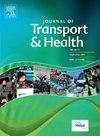Children's happiness and the school route: Linking perceptions of the built environment to wellbeing
IF 3.2
3区 工程技术
Q2 PUBLIC, ENVIRONMENTAL & OCCUPATIONAL HEALTH
引用次数: 0
Abstract
Background
The urban built environment can impact children's wellbeing through exposure to health hazards or conditions that hinder or promote street activities (e.g. active travel, leisure). Children's travel to school is an important way children interact with their environment. However, little is known about the relationship between children's perceptions of the built environment on the route to school, travel mode and the impact this has on their subjective wellbeing.
Methods
Using a bespoke questionnaire, we gathered children's perceptions of the built environment on their school journey (including home street, trip and road outside the school characteristics), frequent active travel to school (3+ days/week) and three wellbeing outcomes: liking the journey, feeling happy and relaxed during the journey, and feeling happy. Multivariate logistic regression was used to explore the association of wellbeing with perceptions of the built environment.
Results
740 children, aged 8–11 years, in seven schools in Bradford, UK. Three built environment perceptions were consistently associated with all measures of wellbeing, feeling: safe from traffic on their trip, that sidewalks were in good condition on their trip, and that there were things to see and do near school. Frequent active travel to school and good air quality were associated with children liking their trip to school but not with feeling happy and relaxed on the journey or generally happy.
Conclusion
Our results suggest that children's perceptions of certain built environment characteristics are important predictors of wellbeing on the school journey. Policy and decision-makers are encouraged to improve the quality of these built environment features (e.g. traffic safety, sidewalks, crossings, and having pleasant things to see and do) to foster children's wellbeing.
儿童的幸福和学校路线:将建筑环境与幸福感联系起来
城市建筑环境可以通过暴露于健康危害或阻碍或促进街头活动的条件(例如积极旅行、休闲)来影响儿童的福祉。儿童上学是儿童与环境互动的重要方式。然而,关于儿童对上学路线上的建筑环境的看法,旅行模式及其对他们主观幸福感的影响之间的关系,我们知之甚少。方法使用定制问卷,我们收集了儿童在上学途中对建筑环境的看法(包括家庭街道,学校外的旅行和道路特征),频繁的主动上学(每周3天以上)和三个健康结果:喜欢旅程,在旅途中感到快乐和放松,感到快乐。多变量逻辑回归用于探索幸福感与建筑环境感知的关系。结果740名8-11岁的儿童,来自英国布拉德福德的7所学校。三种建筑环境感知与所有的幸福指标一致,感觉:旅途中远离交通,人行道状况良好,学校附近有东西可看,有事情可做。频繁的上学旅行和良好的空气质量与孩子们喜欢他们的上学之旅有关,但与旅途中感到快乐和放松或总体上快乐无关。结论:我们的研究结果表明,儿童对某些建筑环境特征的感知是学校旅程中幸福的重要预测因素。鼓励政策制定者和决策者提高这些建筑环境特征的质量(例如交通安全、人行道、人行横道以及有令人愉快的事情可看和可做),以促进儿童的福祉。
本文章由计算机程序翻译,如有差异,请以英文原文为准。
求助全文
约1分钟内获得全文
求助全文

 求助内容:
求助内容: 应助结果提醒方式:
应助结果提醒方式:


